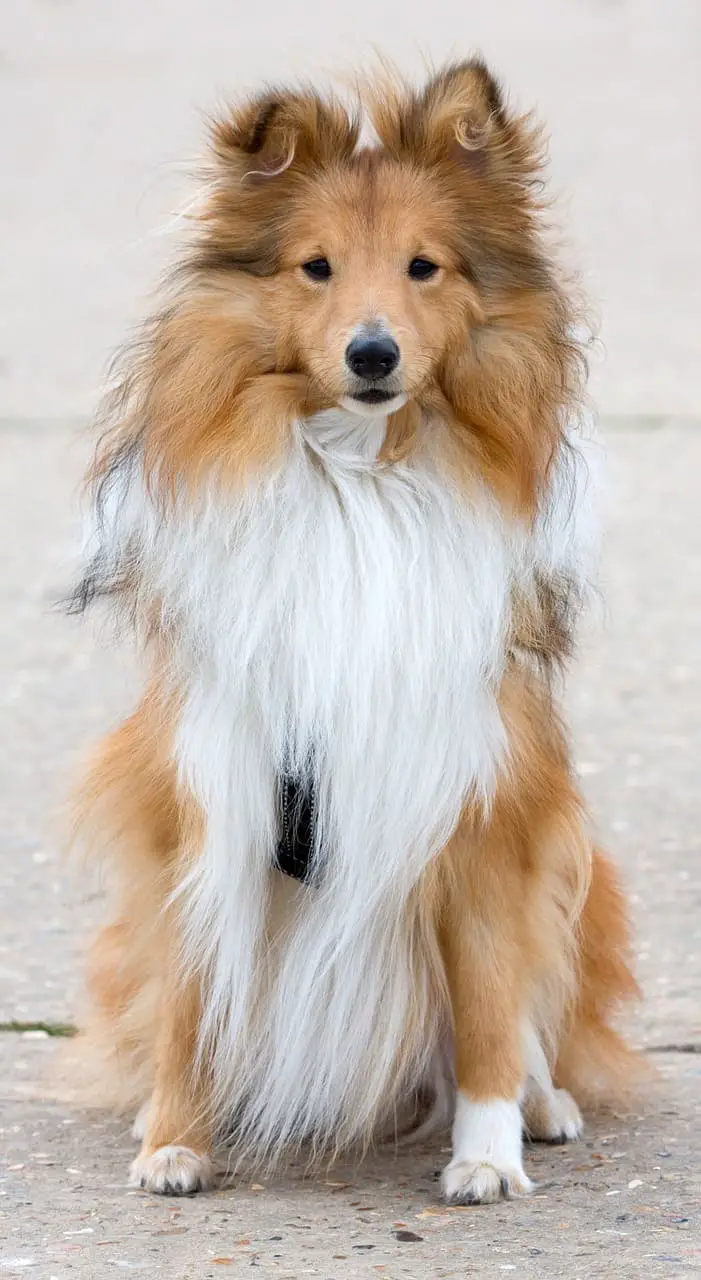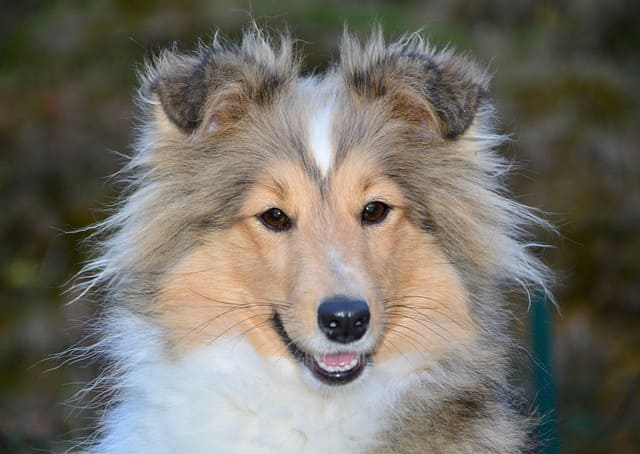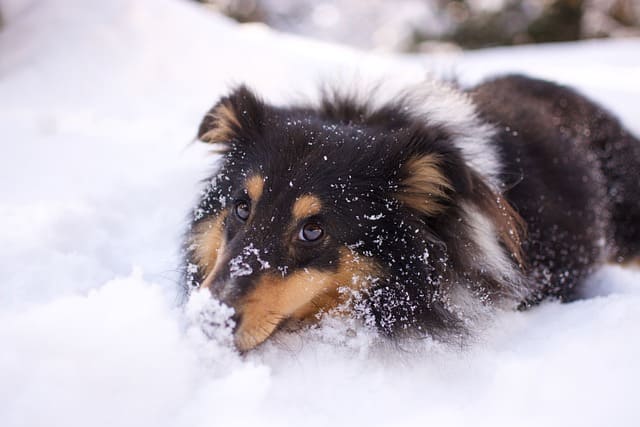The Shetland Sheepdog, often affectionately referred to as the “Sheltie,” is a delightful and intelligent breed known for its herding abilities and striking appearance. These small to medium-sized dogs are not only loyal working companions but also beloved family pets. In this comprehensive guide, we will explore the Shetland Sheepdog breed in detail, delving into their history, physical characteristics, temperament, training needs, health considerations, and much more.
Origins and History

The Shetland Sheepdog has its roots in the Shetland Islands of Scotland, where it was initially bred for herding and working with livestock. Its history is intertwined with that of other herding breeds such as the Rough Collie and the Border Collie. Early Shelties were likely the result of crossbreeding between these breeds, as well as with small, intelligent, and agile local breeds.
These dogs were highly valued for their herding skills and ability to manage the diminutive Shetland Islands’ livestock, which included sheep and ponies. They were bred to be agile, intelligent, and capable of handling the challenging terrain and fickle weather conditions of the region.
The Shetland Sheepdog’s genealogy includes a mix of Collie, Pomeranian, King Charles Spaniel, and possibly other breeds. They were initially known as “Toonies” or “Toonie Dogs” in the Shetland Islands.
The breed started gaining popularity on the British mainland in the early 20th century, with the Shetland Sheepdog Club of Scotland being formed in 1909. The American Kennel Club (AKC) officially recognized the Shetland Sheepdog in 1911, solidifying the breed’s presence in the United States.
Physical Characteristics
The Shetland Sheepdog’s appearance is both distinctive and captivating, showcasing its elegant and refined features. Key physical characteristics of the Shetland Sheepdog include:
Size
Shelties are a small to medium-sized breed. They typically stand between 13 to 16 inches (33 to 41 cm) at the withers and weigh between 15 to 25 pounds (6.8 to 11.3 kg). Males tend to be slightly larger than females.
Coat
One of the most remarkable features of Shetland Sheepdogs is their beautiful double coat. The outer coat is long, straight, and harsh to the touch, while the undercoat is soft and dense. The breed’s coat color can vary and includes sable, black, and blue merle, often with white markings. The striking sable coat can range from light gold to deep mahogany.
Tail
Shelties have a luxurious plume of a tail that is carried high and often curled over the back, adding to their elegant appearance.
Eyes
The Shetland Sheepdog is renowned for its expressive almond-shaped eyes. They are typically dark brown, although blue merle Shelties can have one or both eyes blue or partially blue.
Ears
The breed’s ears are small and triangular, standing erect and tilting slightly forward. They contribute to the Sheltie’s alert and perky expression.
Head
Shetland Sheepdogs have a refined and well-balanced head, featuring a moderately broad skull, clean cheeks, and a straight, moderately short muzzle. The stop is well-defined but not exaggerated.
Nose
The nose is typically black, but liver-colored noses may be seen in blue merle Shelties.
Legs and Paws
Shelties have straight and muscular legs with well-arched toes and thick paw pads. Their well-angulated hindquarters provide them with agility and grace.
Temperament and Personality
The Shetland Sheepdog is renowned for its gentle and intelligent temperament, making it a highly regarded companion and family pet. Understanding their personality is essential for potential owners. Here are some key traits and characteristics associated with Shetland Sheepdogs:
Intelligence
Shelties are among the most intelligent dog breeds, and they are known for their quick problem-solving abilities. Their intelligence, combined with a strong desire to please, makes them highly trainable and capable of learning complex tasks.
Loyalty
These dogs are deeply loyal to their families and often form strong bonds with their owners. They thrive on companionship and enjoy being part of a family unit.
Sensitivity
Shetland Sheepdogs are highly sensitive to their owners’ emotions. They are intuitive and can often sense when their family members are upset or in distress. Their sensitive nature makes them empathetic and affectionate companions.
Alertness
Naturally vigilant and alert, Shelties are excellent watchdogs. They are quick to notice and alert their owners to any unusual activity or potential threats, making them reliable guardians.
Affectionate
Shetland Sheepdogs are known for their affectionate nature. They enjoy being close to their owners and are known to be “velcro dogs” due to their desire to stay by your side.
Playfulness
These dogs have a playful and fun-loving side, often engaging in games and activities that provide both mental and physical stimulation. They thrive on interactive play and enjoy time spent with their family.
Good with Children
Shetland Sheepdogs are typically good with children. They are gentle and patient, making them excellent playmates and companions for kids. However, as with any dog, supervision is essential when they interact with children to ensure a positive experience for both.
Reserved with Strangers
While they are affectionate and loving with their families, Shetland Sheepdogs can be reserved with strangers. They may take some time to warm up to new people and often maintain a sense of aloofness.
Herding Instincts

As a herding breed, Shelties may display herding instincts, even in a non-working setting. They may try to herd family members, especially children, by nipping at their heels or guiding them.
Barking Tendency
Shetland Sheepdogs can be vocal and may bark to alert their owners to various situations. Training and socialization can help manage their barking tendencies.
Training and Socialization
Training and socialization are essential for raising a well-behaved and well-adjusted Shetland Sheepdog. Due to their high intelligence and sensitivity, they respond well to positive reinforcement-based training. Here are some training and socialization tips for Shetland Sheepdog owners:
Early Socialization
Begin socializing your Shetland Sheepdog puppy early to ensure they are comfortable around strangers, children, and other animals. Positive interactions during puppyhood can prevent shyness or aggressive behavior later on.
Obedience Training
Obedience training is vital for teaching your Sheltie basic commands and ensuring they are well-mannered. Enroll in obedience classes or work with a professional dog trainer if needed.
Positive Reinforcement
Shetland Sheepdogs respond well to positive reinforcement techniques, such as treats, praise, and play. Reward good behavior and obeyed commands to motivate them during training sessions.
Exercise and Mental Stimulation
Provide daily exercise and mental stimulation to keep your Sheltie engaged. Long walks, interactive toys, and puzzle games can help channel their energy and prevent boredom.
Leash Training
Proper leash training is essential, as Shetland Sheepdogs can have a tendency to pull on the leash. Invest time in teaching them to walk politely.
Recall Training
Due to their intelligence and desire to please, Shelties typically have good recall. Reinforce this with consistent training, especially in safe, enclosed areas.
Herding Behavior
If your Shetland Sheepdog displays herding behaviors, such as nipping at heels, it’s essential to redirect this instinct into positive activities like agility training or dog sports.
Consistency
Shetland Sheepdogs appreciate a consistent and structured training routine. Consistency helps them understand what is expected of them.
Mental Engagement
Mental stimulation is equally important as physical exercise. Engage your Shetland Sheepdog’s mind with puzzle toys and interactive games to keep them mentally sharp.
Health Considerations
Shetland Sheepdogs are generally healthy dogs, but like all breeds, they can be prone to certain hereditary health issues. Responsible breeding practices and regular veterinary check-ups are crucial for maintaining their overall health. Common health concerns in Shetland Sheepdogs include:
Collie Eye Anomaly (CEA)
CEA is a genetic condition that can affect the eyes of Shelties. It can range from mild to severe and may cause vision problems. Responsible breeders screen for this condition to reduce its occurrence.
Hip Dysplasia
Hip dysplasia is a hereditary condition that affects the hip joints. It can lead to arthritis and lameness. Responsible breeders perform hip evaluations on their breeding dogs to reduce the risk of this condition.
Von Willebrand’s Disease
This is a blood disorder that can affect Shelties. It can lead to excessive bleeding and clotting problems. Responsible breeders test for this condition to reduce its occurrence.
Dermatomyositis
Dermatomyositis is a genetic skin disorder that can affect Shetland Sheepdogs. It typically appears in puppyhood and may cause skin lesions and muscle inflammation.
Thyroid Disorders
Thyroid disorders, particularly hypothyroidism, can affect Shelties. These conditions can result in a variety of symptoms, including weight gain, lethargy, and skin problems.
Epilepsy
Some Shetland Sheepdogs may be prone to epilepsy, a condition characterized by seizures. Medication can help manage this condition in affected dogs.
Sheltie Shaker Syndrome
This condition is unique to the Shetland Sheepdog breed and can cause tremors, muscle weakness, and incoordination. It is typically treatable with medication.
Dental Health
Dental issues can be common in Shelties. Regular dental care, including brushing and dental chews, can help prevent dental problems.
Allergies
Some Shetland Sheepdogs may have skin or food allergies. It’s important to provide a balanced diet and monitor their skin for any signs of irritation or allergies.
Exercise and Activity Needs
Shetland Sheepdogs are an active breed that thrives on regular exercise and mental stimulation. Despite their small size, they have high energy levels and enjoy activities that engage their body and mind. Some of the exercise and activity needs for Shelties include:
Daily Walks
Take your Shetland Sheepdog on daily walks to provide them with physical exercise and an opportunity to explore their environment.
Playtime
Shelties love playtime, so engage them in games of fetch, tug-of-war, and other interactive activities to keep them physically and mentally stimulated.
Agility Training
Agility training is an excellent way to challenge your Sheltie’s mind and body. They excel in agility and often enjoy the mental and physical challenges it provides.
Dog Sports
Consider participating in dog sports such as obedience, rally, or even herding trials if your Sheltie displays herding instincts.
Mental Stimulation
In addition to physical exercise, provide mental stimulation through puzzle toys, interactive feeders, and obedience training.
Off-Leash Play
Shelties enjoy off-leash play in securely fenced areas. Their recall is generally good, but always ensure their safety by providing a secure environment.
Living with a Shetland Sheepdog
Living with a Shetland Sheepdog can be a rewarding experience, but it’s important to understand their unique personality and characteristics. Here are some considerations for potential Shetland Sheepdog owners:
Space Requirements
Shetland Sheepdogs adapt well to various living situations, including apartments and houses with yards. They are small in size but have high energy levels, so regular exercise is crucial regardless of your living space.
Grooming
The Shetland Sheepdog’s beautiful double coat requires regular grooming. They shed throughout the year and more heavily during seasonal changes. Regular brushing helps manage shedding and keeps their coat in good condition.
Herding Behavior
Be aware that Shelties may display herding behaviors, such as nipping at heels. It’s essential to redirect this instinct into positive activities or games.
Socialization
Early socialization is key to ensuring your Shetland Sheepdog grows up to be well-adjusted and well-behaved. Expose them to various situations, people, and other animals to prevent shyness or aggression.
Exercise Commitment
Be prepared to invest time and effort into daily exercise and playtime to keep your Shetland Sheepdog physically and mentally engaged.
Mental Stimulation
In addition to exercise, provide your Shetland Sheepdog with mental stimulation through puzzle toys and interactive games to satisfy their intelligence and curiosity.
Training Patience
Shetland Sheepdogs are intelligent but can be sensitive. Positive reinforcement-based training and patience are key to achieving the best results.
Health Care
Regular veterinary check-ups are crucial to monitor their overall health. Responsible breeding practices are also important to reduce the risk of hereditary health issues.
Choosing a Shetland Sheepdog

If you decide to bring a Shetland Sheepdog into your life, it’s essential to find a reputable breeder or consider adopting from a rescue or shelter. Responsible breeders prioritize the health and well-being of their dogs, perform health tests, and socialize their puppies from a young age.
When choosing a Shetland Sheepdog, consider factors such as the breeder’s reputation, the puppy’s health history, and the compatibility of the breed with your lifestyle and living situation. Remember that owning a Shetland Sheepdog is a long-term commitment, and the breed’s unique characteristics require understanding and dedication.
Conclusion
The Shetland Sheepdog, with its intelligence, loyalty, and striking appearance, is a beloved breed with a rich history of herding and companionship. While they come with certain health considerations and herding instincts, Shetland Sheepdogs make excellent family pets and are known for their affectionate and sensitive nature. Understanding their unique personality and characteristics is key to forming a fulfilling and harmonious relationship with these delightful dogs.
